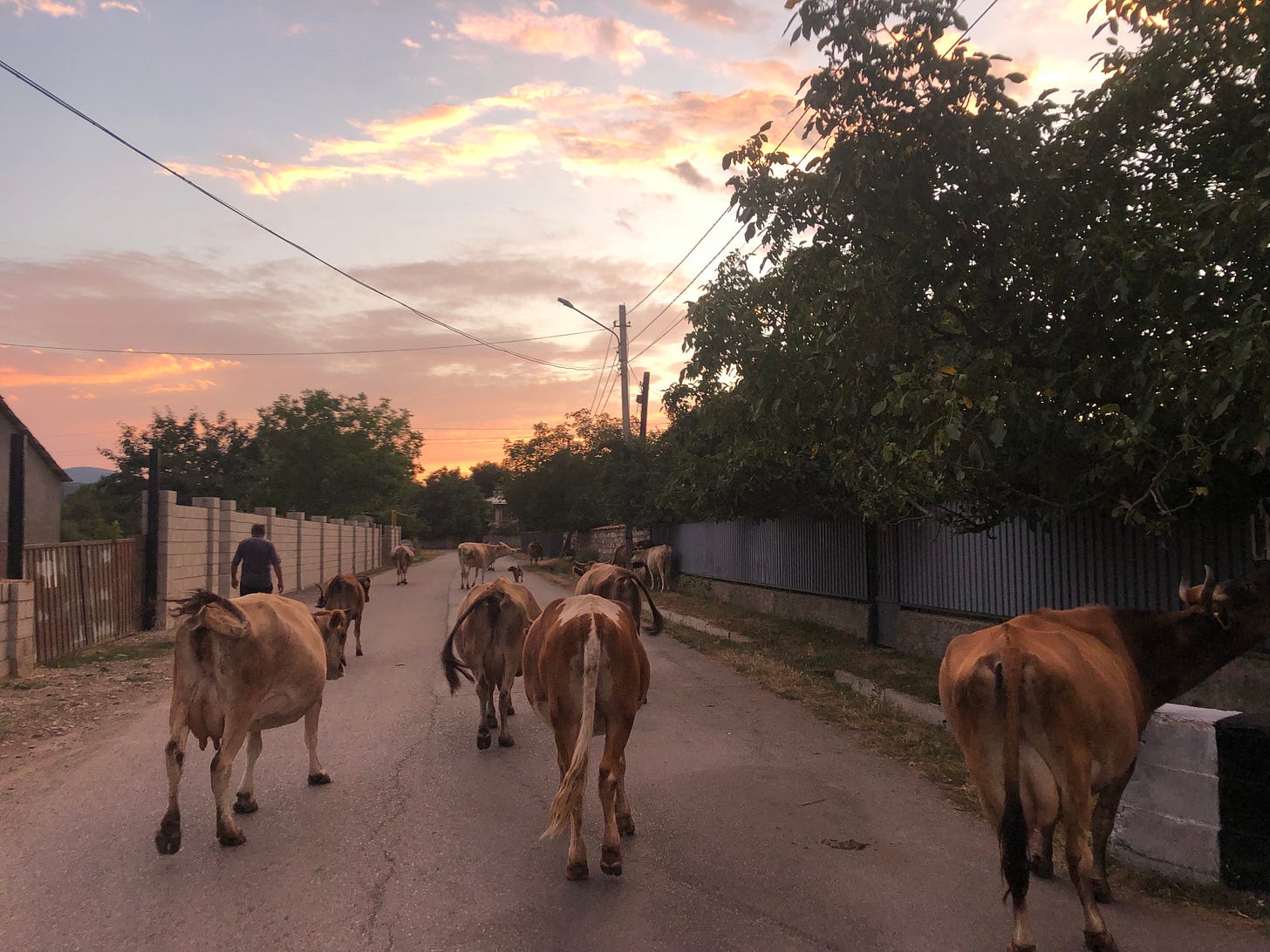The third Georgian cheese that I want to discuss is called Dambalkhacho. It is made on a very small scale in the district of Tianeti, 1.5 hours North of Tbilisi. I saw it made in a home kitchen just across the street from my guesthouse [Link] by a woman named Tamriko Zaridze who milks 3 cows. These cows are taken with the others who live in this neighborhood out to graze after morning milking, with the households taking turns providing a person to serve as herder. In the evening the combined herd comes down the street, the individual cows turning off at their homes. They know where they live.
I also saw it made on a slightly larger commercial scale by a woman named Eka Dojurishvili [Link]. Her effort involves keeping her grandmothers cheese knowledge alive, and offering Dambalkhacho for sale in wider markets within Georgia. There are multiple projects like this in Georgia that I feel are doing a good job at promoting the cultural significance of a cheese and staying true to its tradition, while scaling it up modestly and marketing it in a way that aids the farmers and struggling local economies where small scale dairying is important. She charges a higher price for cheese, as she should, to match the hand labor and aging involved.
Dambalkhacho is a rennetless cheese made with what is essentially skim milk and buttermilk in one. In most countries, butter is made from cream that has been separated from milk. After cream is removed you have a lot of low fat skim milk. There is a whole family of ancient, rennetless cheeses made from the sour skimmed milk made in the Alps, such as Graukase (grey cheese) which I have posted about. This family relies on acid from natural souring, and heat to coagulate a curd that can be made into a wheel and ripened. They end up with distinctive textures as they are low fat, high protein cheeses.
I recognized these textures immediately when I cut into then ate a piece of Dambalkhacho. Gummy on the outside, crumbly in the middle. A distinctive gummy crumble that tells me this cheese is in the same family as graukase. Rather than churning cream for this cheese, they churn whole milk, hence the combined skim milk/buttermilk (butter milk is the liquid left after cream has been churned into butter). Before churning this milk is allowed to sour for 2 days. The sour, post butter skim milk is heated to 60-70c at which point a soft curd separates from a clear grey whey.
The curd drains overnight, then is mashed in a more forceful version of a motion I have seen in the making of Queso Fresco in Mexico. The curd becomes a paste, allowing it to be made into flattened, smooth balls through a lot of violent slapping and hand molding. (Good video of this on my Instagram reels).
These balls are allowed to dry in a warm room or screened area outside for 10 days, becoming yeasty and showing the distinctive growth of yeast forms of Geotrichum.
Once deemed ready they are placed inside pottery vessels or metal pots lined with paper, and aged in a pantry or cellar. The mold like, fluffy form of Geotrichum gets thick, and blue mold often appears in places. The rind looks a lot like that of an aged lactic cheese. Dambalkhacho is a rare moldy, natural rinded cheese, in a country that seems to have few moldy cheeses.
Why the lack of moldy cheeses in a country with a cheesemaking history possible as old as it’s 8000 year winemaking traditions? 70 years of Soviet economic and agricultural policy have something to do with it. The Soviets came into a country with a high diversity of regional cheeses and imposed lacto-monotony. They structured an industrialized dairy system to pump out 4 cheeses, made in factories, all fairly fresh and rindless. To this day, Georgians eat mainly these cheeses, and there seems to be a barrier to acceptance of aged cheese, blues, natural, or bloomy rinds. While Georgia does have fascinating cheeses, they are mainly found in hyper regional pockets, and are hard to obtain outside their homelands. Things are shifting, and big force in that change is my friend Ana Mikadze-Chikvaidze, who has assisted me greatly in my travels here. Check out these links to the articles that inspired me to explore Georgian cheeses and their revival.
I have so many questions about this cheese:
How Ancient is it? No one seems to know.
Why don’t makers of cheeses like Graukase use the buttermilk in their cheese? Maybe there are examples of this?
Why aren’t buttermilk cheeses in general something I have heard of?
Why do the makers here churn whole milk rather than separate cream? It involves so much more volume.
A possible answer is that butter was made by families with 2-4 cows, and the old style churns swung from ceiling chains would hold a days worth of milk.
Studying the diversity of the worlds cheeses and milk fermentation practices is a exercise in consciousness expansion. Things seem to fit into neat categories, but then anomalies appear. Many tradition methods don’t follow what most would consider logical efficiencies. There are just so many ways of getting to the mountain top, so many mountains in the range. Then, thinking you understand what a mountain is, you notice off in the distance, whole other uncharted wild ranges, with forgotten trails, nearly covered in brush and rockslides. The diversity of fermented milk foods is endless.














Fascinating and essential reading cheers Trevor
Just wanted to say how much I love these write-ups with photos, man.
I've followed you on Insta for a while but continuously quit it. These blog posts are a much better format for you.
Love what you're doing mate.
From Melbourne Australia.